1. Introduction
The central dogma of molecular genetics is DNA makes RNA makes protein.
As we’ve seen, making RNA from DNA is called transcription. If you need to, you can learn about transcription by clicking here.
Proteins are polymers of amino acids. In the diagram below, the amino acids are represented by three letter codes: Asn stands for asparagine. Gly stands for glycine.
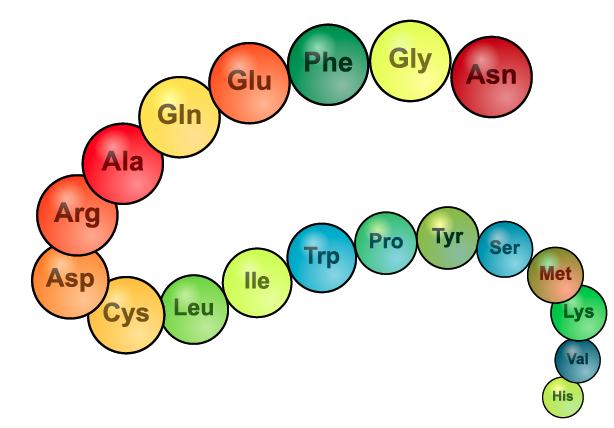
A note about terminology: A string of amino acids like the one shown above is called a polypeptide. When a polypeptide folds up into its three-dimensional shape, it’s considered to be a protein.
All proteins are composed of various combinations of the 20 amino acids found in nature. Because a protein’s shape depends on its sequence of amino acids, it’s essential that the cell be able to translate the information in RNA into the sequence of amino acids that defines a protein’s form and function.
But that leads to a question: how can a message written in RNA, which consists of only four bases (A, U, C, G), specify all twenty amino acids?
2. A Coding Challenge
[qwiz style = “width: 580px; border: 3px solid black; ” qrecord_id=”sciencemusicvideosMeister1961-Coding Challenge 1 (HS)”]
[q labels = “top”]The table below is a code dictionary. Use it to decipher the coded message.
DECIPHER THIS CODED MESSAGE
| ___ | ___ | ___ | ___ | ___ | ___ | ___ |
| CAA | AGU | GAU | AGU | UAA | CGU | ACA |
| ___ | ___ | ___ | ___ | |||
| ACA | GCA | AGG | AGU |
[l]A
[fx] No. Please try again.
[f*] Excellent!
[l]B
[fx] No, that’s not correct. Please try again.
[f*] Excellent!
[l]C
[fx] No. Please try again.
[f*] Great!
[l]D
[fx] No. Please try again.
[f*] Excellent!
[l]E
[fx] No, that’s not correct. Please try again.
[f*] Excellent!
[l]F
[fx] No, that’s not correct. Please try again.
[f*] Correct!
[l]G
[fx] No, that’s not correct. Please try again.
[f*] Excellent!
[l]H
[fx] No. Please try again.
[f*] Correct!
[l]I
[fx] No, that’s not correct. Please try again.
[f*] Correct!
[l]J
[fx] No. Please try again.
[f*] Correct!
[l]K
[fx] No, that’s not correct. Please try again.
[f*] Excellent!
[l]L
[fx] No, that’s not correct. Please try again.
[f*] Excellent!
[l]M
[fx] No. Please try again.
[f*] Good!
[l]N
[fx] No, that’s not correct. Please try again.
[f*] Great!
[l]O
[fx] No, that’s not correct. Please try again.
[f*] Great!
[l]P
[fx] No. Please try again.
[f*] Good!
[l]Q
[fx] No, that’s not correct. Please try again.
[f*] Good!
[l]R
[fx] No. Please try again.
[f*] Good!
[l]S
[fx] No. Please try again.
[f*] Good!
[l]T
[fx] No. Please try again.
[f*] Great!
[l]U
[fx] No, that’s not correct. Please try again.
[f*] Correct!
[l]V
[fx] No. Please try again.
[f*] Good!
[l]W
[fx] No. Please try again.
[f*] Great!
[l]X
[fx] No, that’s not correct. Please try again.
[f*] Good!
[l]Y
[fx] No, that’s not correct. Please try again.
[f*] Excellent!
[l]Z
[fx] No. Please try again.
[f*] Good!
[/qwiz]
Let’s think about what you just did.
The two-word answer is written in our 26 letter English alphabet. But the answer was encoded using just four letters: A, U, C, and G. The way that four letters were able to represent our 26-letter alphabet was to have 3-letter combinations of A, U, C and G code for one letter of our alphabet. AAA coded for the letter “A.” AAC coded for the leter “B,” and so on.
I used the letters A, U, C, and G because each of these letters correspond to one of the four RNA nucleotides (adenine, uracil, cytosine, and guanine). Cells use this same coding system to translate messenger RNA nucleotide sequences into the amino acid sequences of proteins. In the genetic code, groups of three mRNA nucleotides stand for one amino acid. You can see this in the image below:

Three mRNA nucleotides are called a codon. Codon means “codes one.” In the example above, the first codon is AUG, and it codes for the amino acid methionine (Met). The second codon, GUC, codes for valine (Val), and so on.
3. Using a Genetic Code Dictionary
Genetic code dictionaries let you translate sequences of RNA into sequences of amino acids. In other words, if you’re given a sequence of mRNA, you can use a genetic code dictionary to figure out what amino acid sequence that mRNA is coding for.
Let’s say that you wanted to see what amino acids would result from the following mRNA sequence (it’s the one shown in the image above, with the corresponding amino acids removed).
AUGGUCAAGGUUCUCGAUGCAGUCGU
The first step is to find the start codon, AUG. In cells, AUG signals to ribosomes (the cell’s protein factories) where to start translating mRNA into protein. To make things easy, I’ve put the start codon at the start. Next, divide the mRNA into codons (groups of three RNA nucleotides). Do this by drawing a line after every third codon. You’ll wind up with something like what’s shown below.
| mRNA codon | AUG | GUC | AAG | GUU | CUC | GAU | GCA | GUC | CGU |
The next step is to look up each codon in a Genetic Code dictionary. One form of the dictionary is the circular one shown below. In my view, it’s the easiest one to use, so we’ll start with that one.

Here’s how it works.
- The inner ring (yellow) represents the first nucleotide in a codon.
- The second ring (light orange) represents the second nucleotide
- The third ring (orange/red) represents the third nucleotide
- The fourth ring (light blue) tells you the amino acid
- The last ring (green) gives you the three-letter abbreviation for the amino acid.
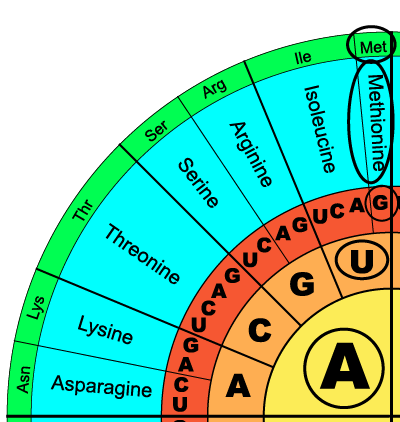 To translate an mRNA codon to an amino acid, just start from the inside and work your way out. Here’s how you would do it for AUG:
To translate an mRNA codon to an amino acid, just start from the inside and work your way out. Here’s how you would do it for AUG:
The first “A” takes you to the upper left of the inside circle, as shown at left. Then move out to “U,” then out again to “G.” The fourth ring shows you that the corresponding amino acid to AUG is “methionine,” and the outermost ring tells you that “methionine” can be abbreviated as Met.
The table below shows you how to translate the next two codons: GUC, and AAG.
| CODON | GUC | AAG |
| DICTIONARY | 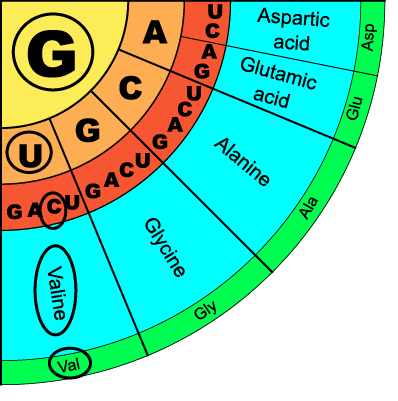 |
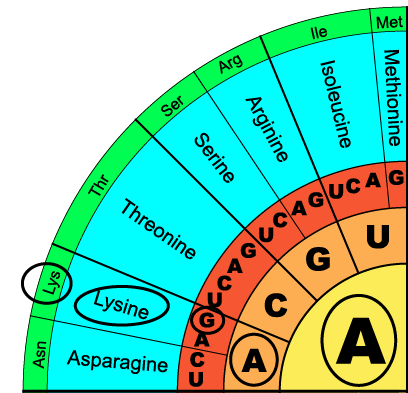 |
| AMINO ACID | Valine | Lysine |
| Abbreviation | Val | Lys |
Now that you’ve worked with the genetic code dictionary, there are two things to note.
- Many codons are synonymous with one another. That means that they code for the same amino acid. Here’s why. With four bases in combinations of 3, there are 43 possible codons. 43 = 64. With only 20 amino acids to code for, it follows that many codons would code for the same amino acid.
- The code includes some “punctuation.”
- The codon AUG codes for methionine, but it’s also the start codon. All genes for proteins begin with the codon AUG, and all resulting proteins being with the amino acid methionine (later, when the protein is processed into its final form, the methionine is often snipped off). AUG, in other words, is like the capital letter that begins a sentence.
- The codons UAA, UAG and UGA are stop codons. Like the period at the end of the sentence, these codons tell the cell when to stop translating mRNA.
- Despite the fact that all proteins begin with methionine and the corresponding codon, AUG, many practice problems will leave this out. If that’s the case, just assume that the first three bases make up the first codon for you to translate.
Another widely used genetic code dictionary has the codons arrayed in a table, as shown below.
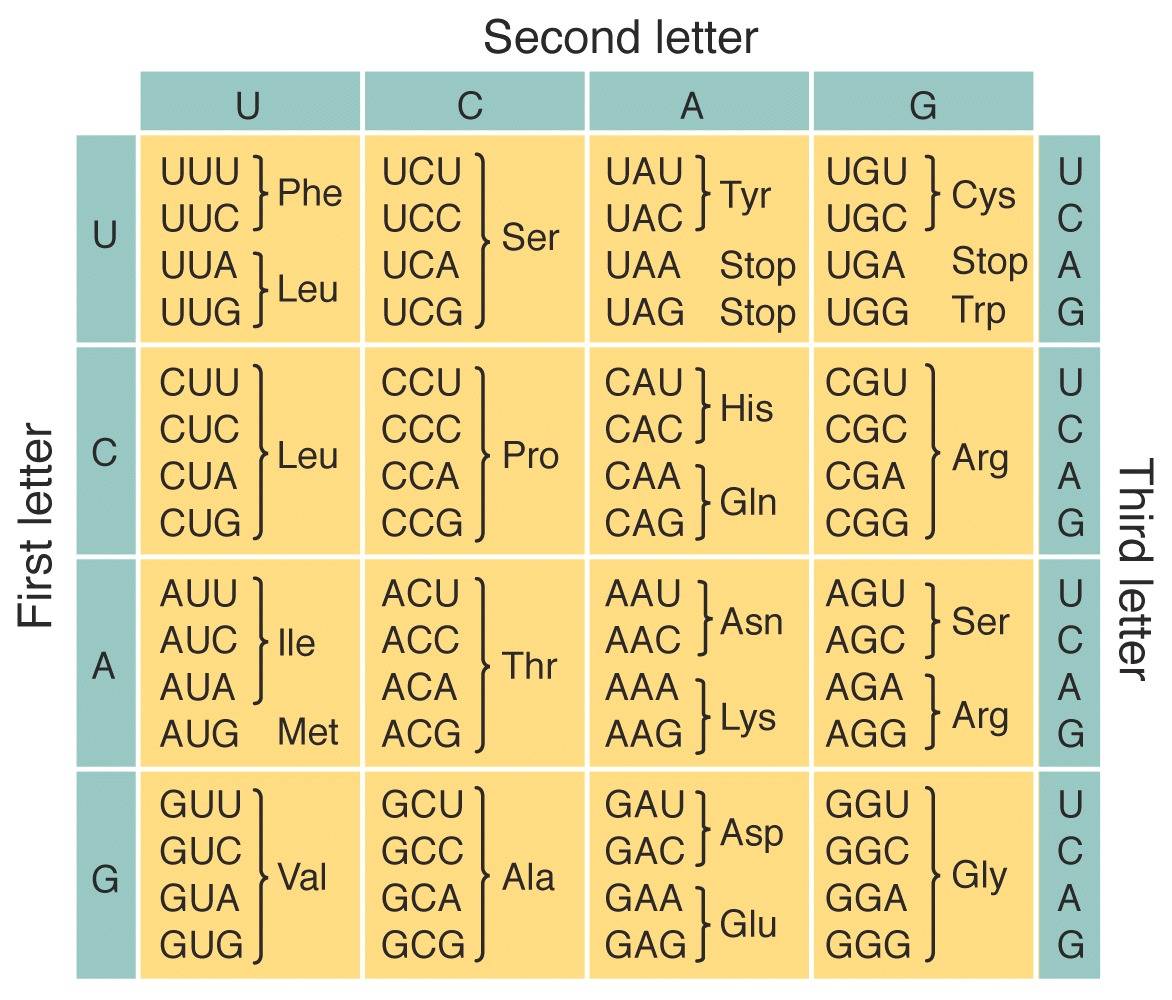
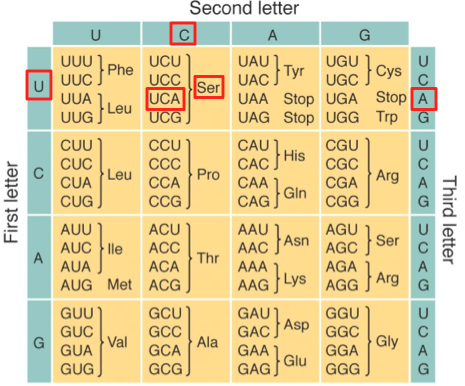 Let’s say that you wanted to translate the codon UCA using this table. Here’s how you’d do it.
Let’s say that you wanted to translate the codon UCA using this table. Here’s how you’d do it.
- Start with the column on the left. Find “U,” the first letter of the codon.
- Use the row on top to find “C,” the second letter of the codon.
- Find the square where this row and column intersect. Now, look over to the right to find “A,” the third letter.
- The specific row where all three intersect lists the codon that you’re looking for (which in this example is UCA). Right next to UCA, you can see Ser, the abbreviation for Serine, the amino acid that corresponds to UCA. Note that this dictionary doesn’t give you the full name for the amino acid, which you might need to look up (for me, another disadvantage of this dictionary).
When you’re working on your own, you can choose whichever dictionary is easiest for you. In class, especially on a test, you might have to work with whatever dictionary your professor provides, so it’s probably a good idea to learn how to use both. For a printer-friendly version of the code, click here.
4. Genetic Code Practice Problems 1: mRNA to Protein
Translate the following mRNA sequences into an amino acid sequence. Dictionaries have been provided for each problem. To give you practice with each, some problems use a circular dictionary, and others use a tabular dictionary. Feel free to print out your own copy of the genetic code dictionary, or, if you’re doing this in a classroom, ask your teacher or professor.
[qwiz qrecord_id=”sciencemusicvideosMeister1961-Genetic Code Practice 1 (HS)”]
[h]Genetic Code Practice Problems: mRNA to Protein
[q labels = “top”]
| amino acids | _____ | _____ | _____ | _____ | _____ | _____ |
| mRNA codons | UAC | UGC | AGU | CCC | GUG | UGA |
[l]Ala
[fx] No, that’s not correct. Please try again.
[f*] Excellent!
[l]Arg
[fx] No, that’s not correct. Please try again.
[f*] Correct!
[l]Asn
[fx] No. Please try again.
[f*] Excellent!
[l]Asp
[fx] No. Please try again.
[f*] Great!
[l]Cys
[fx] No. Please try again.
[f*] Excellent!
[l]Gln
[fx] No. Please try again.
[f*] Excellent!
[l]Glu
[fx] No, that’s not correct. Please try again.
[f*] Good!
[l]Gly
[fx] No, that’s not correct. Please try again.
[f*] Excellent!
[l]His
[fx] No. Please try again.
[f*] Correct!
[l]Ile
[fx] No, that’s not correct. Please try again.
[f*] Excellent!
[l]Leu
[fx] No, that’s not correct. Please try again.
[f*] Correct!
[l]Lys
[fx] No. Please try again.
[f*] Great!
[l]Met
[fx] No. Please try again.
[f*] Correct!
[l]Phe
[fx] No. Please try again.
[f*] Correct!
[l]Pro
[fx] No. Please try again.
[f*] Correct!
[l]Ser
[fx] No. Please try again.
[f*] Great!
[l]Thr
[fx] No. Please try again.
[f*] Correct!
[l]Trp
[fx] No. Please try again.
[f*] Excellent!
[l]Tyr
[fx] No. Please try again.
[f*] Excellent!
[l]Val
[fx] No, that’s not correct. Please try again.
[f*] Good!
[l]STOP
[fx] No. Please try again.
[f*] Excellent!
[q labels= “top”]
| amino acids | _____ | _____ | _____ | _____ | _____ | _____ | _____ |
| mRNA codons | GAG | CAU | AUA | CUG | UUU | AGA | UUC |
[l]Ala
[fx] No. Please try again.
[f*] Good!
[l]Arg
[fx] No. Please try again.
[f*] Good!
[l]Asn
[fx] No. Please try again.
[f*] Excellent!
[l]Asp
[fx] No, that’s not correct. Please try again.
[f*] Great!
[l]Cys
[fx] No. Please try again.
[f*] Good!
[l]Gln
[fx] No. Please try again.
[f*] Good!
[l]Glu
[fx] No, that’s not correct. Please try again.
[f*] Correct!
[l]Gly
[fx] No. Please try again.
[f*] Excellent!
[l]His
[fx] No, that’s not correct. Please try again.
[f*] Good!
[l]Ile
[fx] No, that’s not correct. Please try again.
[f*] Great!
[l]Leu
[fx] No. Please try again.
[f*] Good!
[l]Lys
[fx] No, that’s not correct. Please try again.
[f*] Great!
[l]Met
[fx] No. Please try again.
[f*] Correct!
[l]Phe
[fx] No, that’s not correct. Please try again.
[f*] Excellent!
[l]Pro
[fx] No. Please try again.
[f*] Good!
[l]Ser
[fx] No. Please try again.
[f*] Excellent!
[l]Thr
[fx] No. Please try again.
[f*] Good!
[l]Trp
[fx] No. Please try again.
[f*] Great!
[l]Tyr
[fx] No. Please try again.
[f*] Excellent!
[l]Val
[fx] No. Please try again.
[f*] Correct!
[l]STOP
[fx] No, that’s not correct. Please try again.
[f*] Correct!
[x]
[restart]
[/qwiz]
5. Genetic Code Practice Problems Set 2: DNA to Protein
In the problems above, you translated sequences of mRNA into the sequences of amino acids that make up a protein.
To demonstrate that you understand molecular biology’s central dogma (DNA makes RNA makes protein), you’ll want to be able to start with sequences of DNA, transcribe them into RNA, and then use a genetic code dictionary to translate the mRNA into protein. In what follows, I’ll mark DNA, RNA, and protein with colors to try to clarify what’s what.
Let’s use this DNA sequence: CCGGCTAGCGTCTGA as an example.
The first step is to transcribe the DNA into RNA. Remember that T(thymine) in DNA is replaced by U (Uracil) in RNA. That means that during transcription, A in DNA generates a U in RNA, as shown below. For exercises transcribing DNA into RNA, click here.
| mRNA codons | GGC | CGA | UCG | CAG | ACU |
| DNA (triplets) | CCG | GCT | AGC | GTC | TGA |
Next, use the genetic code dictionary to translate the mRNA into an amino acid sequence.
| Amino acids | Gly | Arg | Ser | Glu | Thr |
| mRNA codons | GGC | CGA | UCG | CAG | ACU |
| DNA (triplets) | CCG | GCT | AGC | GTC | TGA |
Ready? Try a few practice problems to see if you’ve got it. To prompt you to remember to transcribe the DNA to RNA before translating, I’ve left an empty row in the table. A good technique would be to write down the mRNA codons on a piece of scrap paper, then translate them into amino acids.
[qwiz qrecord_id=”sciencemusicvideosMeister1961-Genetic Code Practice 2 (HS)”]
[h]Genetic Code Practice 2: DNA to Protein
[q labels = “top”] Remember to transcribe before translating!
| amino acids | _____ | _____ | _____ | _____ | _____ |
| mRNA codons | |||||
| DNA | GTA | CTC | TTA | ACC | ACT |
[l]Ala
[fx] No. Please try again.
[f*] Excellent!
[l]Arg
[fx] No. Please try again.
[f*] Excellent!
[l]Asn
[fx] No, that’s not correct. Please try again.
[f*] Great!
[l]Asp
[fx] No. Please try again.
[f*] Correct!
[l]Cys
[fx] No. Please try again.
[f*] Excellent!
[l]Gln
[fx] No. Please try again.
[f*] Excellent!
[l]Glu
[fx] No, that’s not correct. Please try again.
[f*] Great!
[l]Gly
[fx] No. Please try again.
[f*] Great!
[l]His
[fx] No, that’s not correct. Please try again.
[f*] Good!
[l]Ile
[fx] No. Please try again.
[f*] Good!
[l]Leu
[fx] No, that’s not correct. Please try again.
[f*] Good!
[l]Lys
[fx] No. Please try again.
[f*] Excellent!
[l]Met
[fx] No, that’s not correct. Please try again.
[f*] Excellent!
[l]Phe
[fx] No. Please try again.
[f*] Excellent!
[l]Pro
[fx] No. Please try again.
[f*] Excellent!
[l]Ser
[fx] No, that’s not correct. Please try again.
[f*] Correct!
[l]Thr
[fx] No. Please try again.
[f*] Correct!
[l]Trp
[fx] No, that’s not correct. Please try again.
[f*] Great!
[l]Tyr
[fx] No, that’s not correct. Please try again.
[f*] Excellent!
[l]Val
[fx] No. Please try again.
[f*] Correct!
[l]STOP
[fx] No. Please try again.
[f*] Correct!
[q labels = “top”]
| amino acids | _____ | _____ | _____ | _____ | _____ |
| mRNA codons | |||||
| DNA | CCA | AAG | AAC | TCA | AGT |
[l]Ala
[fx] No. Please try again.
[f*] Correct!
[l]Arg
[fx] No. Please try again.
[f*] Correct!
[l]Asn
[fx] No, that’s not correct. Please try again.
[f*] Correct!
[l]Asp
[fx] No, that’s not correct. Please try again.
[f*] Good!
[l]Cys
[fx] No, that’s not correct. Please try again.
[f*] Correct!
[l]Gln
[fx] No, that’s not correct. Please try again.
[f*] Good!
[l]Glu
[fx] No, that’s not correct. Please try again.
[f*] Excellent!
[l]Gly
[fx] No. Please try again.
[f*] Correct!
[l]His
[fx] No. Please try again.
[f*] Correct!
[l]Ile
[fx] No, that’s not correct. Please try again.
[f*] Correct!
[l]Leu
[fx] No, that’s not correct. Please try again.
[f*] Excellent!
[l]Lys
[fx] No, that’s not correct. Please try again.
[f*] Correct!
[l]Met
[fx] No. Please try again.
[f*] Great!
[l]Phe
[fx] No. Please try again.
[f*] Excellent!
[l]Pro
[fx] No, that’s not correct. Please try again.
[f*] Excellent!
[l]Ser
[fx] No, that’s not correct. Please try again.
[f*] Correct!
[l]Thr
[fx] No, that’s not correct. Please try again.
[f*] Correct!
[l]Trp
[fx] No, that’s not correct. Please try again.
[f*] Great!
[l]Tyr
[fx] No. Please try again.
[f*] Excellent!
[l]Val
[fx] No, that’s not correct. Please try again.
[f*] Great!
[l]STOP
[fx] No. Please try again.
[f*] Correct!
[/qwiz]
What’s Next?
- Proceed to the Protein Synthesis Tutorial (the next high school level tutorial in this series)
- Return to the RNA, Transcription, and Translation (HS Level) Main Menu
